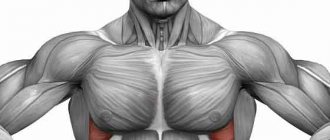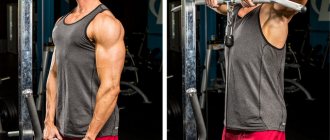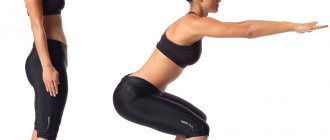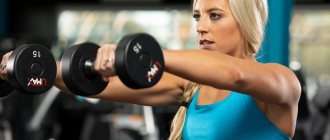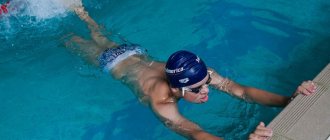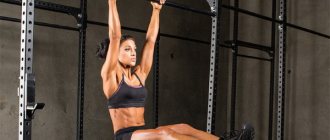It is known that the strength of a chain is determined by the strength of its weakest link. Human skeletal muscles can also be compared to a chain that has a weak link: this is the stabilizing muscles of the middle of the body. If this area lags behind in its development, the athlete cannot avoid injuries.
Problems with the lower back, sprains and tears in the abdominal muscles when working with heavy (and sometimes not very heavy) weights - all this, unfortunately, is common for those who do not pay enough attention to training the core muscles, which will be discussed in this article.
Dynamic bar
This is one of the many versions of the bar, but in dynamics. This exercise can work almost your entire core in a short period of time—according to Richard Wilcock, the dynamic plank works 6 different core muscle groups.
Technique:
- Stand in a regular elbow plank position with your forearms on a ball (preferably an exercise ball).
- Keeping your core engaged and your body still, begin rolling the ball in a small clockwise circle using your hands. 1 round – 1 rep.
Do the required number of repetitions.
How to work your core muscles? Basic exercises in various styles
The core includes dozens of different muscle fibers, so it is impossible to pump it up using any one specific technique - you will have to constantly combine exercises, change approaches and supplement your training with new skills. To achieve tangible results in an extremely short time, try choosing a combination of basic pumping methods:
- Side and straight planks on the elbows and arms will strengthen the torso and increase the static strength of the core. Gradually increase the time interval and the number of approaches, and you yourself will not notice how the position will not cause difficulties.
- Twisting, lifting the torso and legs is a universal way to pump up the abs, which also has a positive effect on the condition of the core.
- Side bends will make your waist thinner by pumping up the oblique abdominal muscles.
- The glute bridge and its various variations will strengthen the back muscles, hips and pelvis.
- Straight-back push-ups are a great option for increasing body stability in space.
- Rope climbing will strengthen your upper torso.
Another great way to help pump up your core muscles is yoga. Correctly performed asanas will improve the condition of the torso, make the body more flexible and resilient. Positions that include balance on the arms or one leg, inverted asanas and the smooth dynamics inherent in yoga have a positive effect on the strength and durability of muscle fibers of various groups. During the exercises, even deep-seated muscles are used, which are rarely involved in classical sports exercises.
"Bird Dog"
This exercise comes from yoga. It involves almost the entire body and is aimed at finding balance. According to certified trainer and Aaptiv (fitness app) head instructor Jaime McPhaden, bird dog is a healthy, low-impact exercise that helps improve stability and coordination without putting too much pressure on your joints.
Technique:
- Get on all fours, knees at a 90-degree angle, hands under your shoulders. Remember to keep your abs tense and your back straight.
- Extend your right arm straight out in front of you and at the same time move your left leg back.
- Complete the movement by connecting your right elbow with your left knee under your body. Return to the starting position and repeat the same with your left arm and right leg.
Do the required number of repetitions.
see also
17 real weight loss tips from people who have lost more than 20 kg
| Further | Back | Start | End | List |
8.6. The problem of associativity of types: an algorithm for generating logical statements
Problem formulation
Let the feature space X
dimension
m
> 1, corresponding to a certain list of aquatic species, is previously converted to a binary form, i.e.
xi
= 1 if the abundance value of
the i
-th species in the sample exceeds a certain specified threshold, and
xi
= 0 otherwise,
i
= 1,2,…,
m
.
Let also the training sequence, which includes specially selected measurements x
from
X
, be divided into two subsets of vectors - vectors of the first class
X
and vectors of the second class.
It is necessary to search the training sample for consistent logical patterns and form a certain system of logical decision rules, each of which contains information contained not only in individual features, but also in various combinations of feature values.
The biological meaning of the formed logical constructions lies in an attempt to identify, within given biocenoses, evolutionarily established sets of interdependent, contacting organisms connected by a common fate (consort groups, associations, synusia, etc.).
Recommended reading: [Bongard, 1967; Weinzweig, 1973; Golender, Rosenblit, 1978].
Math worksheet
Consider a logical recognition method known as the “Kora” algorithm, which is widely used in geological exploration and drug screening.
A set of characteristic logical functions Y ( x
,t), which are called logical statements and represent some combination of the original variables
x
ij, interconnected by the operation of conjunction, i.e.
sign of the logical product “AND” (AND, Ù): xi1
Ù
xj2
Ù
… Ù
xkl , where
i
,
j
,
k
О
M
are the indices of the original dictionary of features,
l
= 1¸ 5 – the number of elements in the logical statement or its rank.
Each of the factors can be interpreted in the language of Boolean algebra as “True” (TRUE for xij
= 1) or its negation, i.e.
“False” (NOT TRUE or FALSE when xij
= 0).
The “Kora” algorithm repeatedly scans the training sample, previously divided into two classes (0 and 1), and, using the operations of logical algebra, selects from the set of statements the so-called consistent logical statements Y ( x
,t
*
), covering the entire set of examples. A consistent statement for each class is a conjunction that occurs a certain number of times only in one class and never occurs in another. When generating logical statements, the algorithm is guided by a number of the following rules:
- 1. Conjunctions are sorted by productivity or power, estimated by the number of observations for which this statement is true. The greater the productivity of the conjunction, the higher the predictive value of the selected combination of features. In the case of a deterministic recognition problem, the final decision rule includes conjunctions whose productivity exceeds a certain threshold D.
2. Subordinate (or child) conjunctions that completely contain shorter candidates are excluded from the generated list. After such an absorption operation, the redundancy of the decision rule is eliminated, in which conjunctions of minimal rank remain, containing the selected patterns in a concentrated form.
3. Statements that, according to certain criteria, are considered “prejudice” are excluded. These include conjunctions that are not associated with an objective classification rule, but due to the limited sample size, received good marks in training. To identify features prone to prejudice, a bootstrap procedure is performed in which the training sample is repeatedly randomly divided into classes. The sample divided in this way is a test that allows us to assign penalty points for prejudice to each initial characteristic. Conjunctions that have accumulated an excess number of penalty points are excluded from the decisive rule.
The description of each class is the logical sum (disjunction) of a certain number of consistent and productive conjunctions that have gone through the selection stages described above. The combination of these logical statements represents a kind of mosaic-fragmentary dividing surface of a special type (as opposed to the linear surface of a “generalized portrait”). It is possible to use the generated conjunctions to examine test examples based on the voting principle (the conjunctions are used as an “electorate”). However, we believe that the special value of using the “Bark” algorithm lies in extracting from the sea of initial data unconventional and consistent hypotheses about the ecology of species - the phenomena of their mutual conditionality or competition.
The “Kora” algorithm, like other logical methods of pattern recognition, is quite labor-intensive, since the selection of conjunctions requires a complete or partially directed search. Therefore, when using logical methods, high demands are placed on the efficient organization of the computational process, and these methods work well with relatively small dimensions of the feature space and the capacity of the specified class of characteristic functions.
Case Study
We use the “Kora” algorithm for logical-structural analysis of the same training sample as in algorithm 2 of section 8.5. Let us recall that the alphabet of characters corresponded to 166 species of chironomids, class X
included 70 samples at stations with a relatively satisfactory environmental situation (NORM), and the class included 90 measurements in an area with an environmental emergency (PATHOLOGY).
A small part of the received statements is given in table. 8.21. For example, the species Microtendipes pedellus
was found in 9 observations of the NORM class and in not a single observation of the PATHOLOGY class.
A combination of the species Cladotanytarsus mancus
and
Cricotopus bicinctus
with the inevitable absence
of Cryptochironomus
gr
.
defectus achieved the same 8 times. Logical statements of the PATHOLOGY class are somewhat poorer and often turn out, at least in fragments, to be a mirror image of conjunctions of the NORM class.
Table 8.21
Fragments of logical decision rules obtained by algorithm and characterizing water quality categories based on the species composition of chironomids
| Further | Back | Start | End | List |
Gluteal bridge
“Weak core muscles are often associated with weak gluteal muscles,” noted trainer Jaime, already familiar to us. According to the expert, this is an ideal exercise that you can do not only in the gym but also at home to strengthen your hamstrings and buttocks.
Technique:
- On the mat, lie on your back with your knees bent and your feet flat on the floor. Keep your heels directly under your knees. Place your arms at the sides of your body, palms down.
- Push off with your heels, straining your buttocks and abdominal muscles, lift your pelvis as high as possible.
- Hold at the maximum point for a few seconds, making sure that your spine does not round and your pelvis does not sag.
- Return to the starting position.
Do the required number of repetitions.
What are the core muscles responsible for?
Unlike most muscle fibers, the core is not an independent source of movement - this group is largely responsible for the correct distribution of force impulses. Based on this, its key functions are determined:
- The core acts as a stabilizer of the body in space, especially during heavy loads. Well-developed muscles of this complex protect the spinal column from injuries and hernias, maintain balance and flexibility.
- Stabilization of the core muscles is the basis for the correct shape of the chest, beautiful posture and toned silhouette, distinct relief of the abdomen and buttocks.
- The deep core muscles help position the internal organs in an anatomically correct position, prevent their displacement, and therefore ensure the full functionality of all body systems.
- Strengthening the core muscles is especially important for women. The pumped fibers support the internal organs of the reproductive system, which is very important during pregnancy, childbirth and subsequent recovery.
- A developed core allows you to easily perform exercises that require “explosive” strength: jumping, skipping, hitting, etc.
- Weak core muscles are unable to support complexly coordinated movements. They limit the trajectory of movement and functionality of the body, which is especially important in gymnastics and yoga, which require flexibility and coordination.
The core is involved to one degree or another in almost every movement, helping to stabilize the back, pelvis, hips and other parts of the body, distributing the load between muscles and preventing injuries to the musculoskeletal system. Therefore, even if you do not play sports professionally and do not carry heavy weights, it is worth regularly doing at least basic core muscle exercises at home. This will help train poorly developed muscles, and also make the body stronger and healthier.
"Cot"
The “clamshell” will help strengthen the muscles of the hips and pelvic floor even for those who are still new to the world of fitness. The exercise evenly distributes the load between the muscles of the inner and outer thighs.
Technique:
- Lie on your side with one leg crossed over the other. Bend your knees at an angle of 45 degrees.
- Place your head on your forearm.
- Pull your stomach in, as if pulling your navel towards your spine.
- Keeping your feet touching, lift the knee of your top leg as high as possible. Try to make the movement only with your knee, without rotating your pelvis. Your bottom leg should not leave the floor.
- At the top, pause for one count, then return your leg to the starting position.
Repeat.
Pallof press
Side pulley forward press. This is a core strengthening exercise that also forces the body to minimize stress on the back during various body movements, such as squats or running.
Technique (in the gym):
- Attach a standard overhead pulley D-handle and position it at shoulder height. You can also use the bottom block.
- Standing with the left side of your body at the machine, grab the handle with both hands and move away from the block a few steps to feel the tension on the cable.
- Place your feet shoulder-width apart and bend your knees slightly. Hold the handle at mid-chest level - this will be the starting position.
- As you exhale, pull the cable with straight arms. The core muscles should be tense and engaged. Hold for 2 seconds before returning to the starting position.
Do 10 reps on each side.
How to assess core muscle development? Home test for beginners
If you have been actively involved in sports for a long time and monitor the condition of your body, this does not mean that your core is in optimal condition. A special test for core muscle strength, including a functional assessment of movements, will help measure the degree of its development. A system of seven different exercises, developed by American specialists G. Cook and L. Burton, will allow you to assess your basic athletic level and subsequently correctly create a set of exercises for developing the core muscles that you can do.
"Dead Bug"
The Dead Bug is a static exercise that targets the abdominal, back and thigh muscles. Doing it regularly will make it much easier to do other exercises that involve moving your legs and arms while keeping your abdominal and back muscles stationary but engaged.
Technique:
- Lie on the floor, bend your knees and lift them so that a right angle forms between your knees and hips.
- Extend your arms towards the ceiling.
- Reach your left leg with your right hand. Try not to lift your lower back off the floor.
- Pause and return to the starting position.
- Repeat with the other arm and leg.
Do the required number of repetitions.
see also
The Real Reasons Why Muscles Get Tired During Exercise
Core training (option #2)
The second version of core training includes equally effective exercises for pumping up the muscle corset. You don't need to train your core muscles every day, 2-3 times a week is enough. Alternate two plan options with each other to avoid monotonous loads.
Low impact burpees
How to do it : Leaning towards the floor, lean on both palms, take two steps back and go into hand plank pose. Moving along the reverse amplitude, you need to take the starting position, thereby completing the repetition.
How to make it easier: To make this core exercise easier, you can move into a plank position on a bench, sofa, or chair.
How much to perform: 10-15 repetitions.
Up and Down Plank Raises
How to do it : Assume a plank position with your arms extended. Tighten your stomach, straight back, body forms a straight line. Then begin moving into a forearm plank position, bending one arm at a time. Perform the entire set on one arm (i.e., bending first the right arm, then the left), then switch sides.
How to make it easier : Get down on your knees for an easier version of the exercise.
How much to do: 10-12 repetitions, first on one side, then on the other.
Lifting the sit-up body
How to do it : While lying down, bend your legs and lock them on your feet. Your arms should be crossed over your chest to avoid jerking and inertial movements during work. After this, lift your body to a position perpendicular to the floor, and then return back.
How to simplify : You can perform body lifts with your hands on the floor.
How much to perform: 15-20 repetitions.
Body rotations with press bending
How to do it : Sit on the mat and bend your legs slightly. Place your arms in front of you, turning your elbows to the right and left sides of each other. Tilt your body back while rotating it. Touching your elbow to the floor behind you, return to the starting phase. For the next repetition, the direction of rotation changes.
How to simplify : Perform body turns without lifting the body to the knees.
How much to perform: 15-20 repetitions on each side.
Scissors
How to do it : Lie on your back, then slightly raise your upper back and legs, keeping your lower back pressed to the floor. After this, perform alternating lifts of the upper and lower extremities, maintaining a small range of motion.
How to simplify : Since the lower abs are often the lagging link in the muscular skeleton of beginning athletes, to simplify the exercise, place your hands under your buttocks. You can place your head on the floor.
How much to do: 20-25 lifts on each side.
Steps with hands forward in plank
How to perform : The movement is performed in a standard plank with straight arms. Your task is to take alternating steps forward on your upper limbs, and then back. The legs remain in a stationary position. This significantly complicates the element, making it more efficient and functional.
How to make it easier : Perform this core exercise in a plank position on your knees.
How much to do: 10-15 repetitions, first on one side, then on the other.
Superman
How to do it : Lie on your stomach with your head slightly raised. After this, begin to lift your lower and upper limbs with effort, but without strong jerks, about 15 cm from the floor. After holding the dive for a second, gently lower your arms and legs to the floor.
How to simplify : Simultaneous lifting is quite a serious load on the lower back, so work first with your upper limbs, and then with your lower limbs in turn.
How much to perform: 15-20 repetitions.
Raising arms and legs while standing on all fours
How to do it : Get on all fours, then extend your right arm and left leg lengthwise. Once you reach the peak point, lower your limbs and switch sides. Dynamic movements with changing sides are performed for each new repetition.
How to simplify : Raise the opposite arm and leg at the same time, but without twisting, but returning your palms and feet to the mat.
How much to do: 15-20 repetitions, first on one side, then on the other.
Side plank twists
How to do it : While holding a plank on your forearms, you need to rotate your body to get into a side plank position. After this, return to the starting position and change the direction of rotation. At the peak points, the free hand is fixed on the belt.
How to simplify : Do not go into a full side plank, but only slightly turn your body to the side, transferring your weight to one supporting hand.
How much to do: 10-15 repetitions on each side.
Pulling your knees to your chest
How to do it : Lying on your back, stretch your legs at an angle of 45 degrees. Slightly lift the top of your body off the floor, then rotate your arms in a circular motion, while simultaneously bringing your knees to the level of your solar plexus. When the arms move back, the legs straighten.
How to Simplify : To simplify this effective core exercise at home, start with just your legs while keeping your arms extended above your head.
How much to perform: 15-20 repetitions.
Straight leg cross touches
How to do it : Raising your legs perpendicular to the floor, you need to alternately reach with your hands to the toe of the opposite side. Initially, the hands are brought together at the back of the head with the elbows facing oppositely.
How to make it easier : The exercise requires good static abdominal strength, so to make it easier, bend your knees (shins parallel to the floor).
How much to perform: 15-20 repetitions on each side.
Knees to chest fold
How to do it : Lying on your back, try to maintain the balance of your torso with support on your buttocks. The legs and body are slightly lifted off the floor, the arms are spread out in a T-shape. After this, raise your knees, simultaneously leaning towards them with your body and wrapping your arms around them. In the reverse phase, return to the starting position.
How to simplify : Lower your legs onto the mat while straightening, you can stretch your arms along your body.
How much to perform: 15-20 repetitions.
Bridge with steps
How to do it : Rest your shoulder blades and the back of your head on the floor, then lift your pelvis off the floor and place your bent legs on your full feet. Your task is to step forward twice, and then take two steps back. Similar movements are performed for the required number of repetitions.
How to simplify : Take one instead of two steps forward.
How much to perform: 10-15 repetitions.
Plank with hip rotation
How to do it : Standing in an elbow plank, rotate your hips to the right and left so that the outer side of your pelvis touches the floor at the peak point. The body must remain fixed in a static position.
How to simplify : Do not perform amplitude rotations of the pelvis to the floor; to begin with, it is enough to do a small twist in a small amplitude.
How much to perform: 15-20 repetitions on each side.
"A hundred"
“The Hundred” is a fairly simple but effective exercise that comes from Pilates. It is aimed at stabilizing the lumbar spine and strengthening the abdominal muscles. Daniela Caesar-Roden, a certified Pilates instructor at Old School Pilates, notes that it's important to pay attention to breathing, as the exercise also affects the diaphragm, which stabilizes the core muscles, especially during deep exhalations.
Technique:
- Lie on your back, place your arms along your torso, raise your legs and bend them at a right angle.
- Exhale and use your abdominal muscles to lift your upper body off the floor. Press your lower back to the floor by tensing your abdominal muscles and drawing in your abdomen.
- Raise your arms parallel to the floor and hold.
- Keeping your legs at right angles (or, if you want to complicate the exercise, at an angle of 45 degrees), begin to make up and down patting movements with tense hands, without bending your elbows or touching the floor. Do 5 beats on a long inhale and 5 beats on a long exhale. Remember to keep your core tense. You have completed 1 cycle. Over time, try to do up to 10 cycles.
Core training (option #1)
We offer you two ready-made sets of core exercises that you can perform at home. To complete it you will not need additional equipment. Most of the exercises are suitable for more or less experienced practitioners, but the description offers a simplified version of the exercise, so you can always optimize the workout to suit your level of training. In addition, you can first reduce the number of repetitions by 2 times, gradually increasing the load. Gradually, the muscles will become stronger, and you will be able to complete the entire exercise without difficulty.
The core workout consists of 30 exercises with a specific number of repetitions. You can change the number of repetitions up or down depending on your training experience and muscle strength. Take a short rest between exercises: 30 seconds (beginners), 10-15 seconds (advanced). You can repeat the exercises twice, resting 2 minutes between circles.
Steps on hands to plank
How to do it : From a standing position, you need to bend your body and stand on your full palms. After this, take a few steps on your hands, trying to get into a plank position on your hands. Use the opposite amplitude to return to the starting phase, straightening your body again.
How to simplify : A core exercise at home can be simplified if you do not straighten up completely, but step back and forth without taking your hands off the floor. It would not be amiss to train a regular plank in order to strengthen the muscles necessary for work.
How much to perform: 10-15 repetitions.
Push ups
How to do it : In the process of push-ups, the main factor is the correct placement of the hands. Palms are directed along the body. Keep your elbows near the sides of your body, without spreading them wide. Get down as low as possible, almost touching the floor with your chest.
How to make it easier : Start doing push-ups from your knees. The second simplification option is to do push-ups while leaning on a bench or sofa. Moreover, the higher the surface of the bench, the easier it is to perform the exercise.
How many to perform: 8-15 repetitions.
You can do the exercise from your knees:
Crunches with legs raised
How to do it : Lie on your back and raise your bent legs. The hands are brought together at the back of the head with the elbows straightened in different directions. Twisting is performed by the upper part of the body. Take your time while working, reaching the maximum tension at the peak point.
How to simplify : A similar core training exercise in the initial stages can be practiced without lifting the legs. Variations in placing the bent legs on the heel are allowed, which will also complicate the element and make it more effective.
How much to perform: 15-20 repetitions.
Bike
How to do it : Do not change the position of the previous exercise. Your task is to alternately pull your knees to your chest as if pedaling a bicycle. At the same time, the body is also twisted. The opposite elbow and knee meet at the peak point of the movement. The work is carried out at a moderate pace.
How to simplify : First, work only with your legs, trying to “pedal” without connecting the work with your body. You can hold your knees with your hands while pulling them to your chest.
How much to perform: 15-20 repetitions on each side.
Leg raise while lying on your back
How to do it : While lying on your back, you need to slightly raise your head. Support it with your hands at the back of your head. After this, begin to lift both legs at the same time until the limbs are perpendicular to the floor surface. Don't lower them all the way to keep your abs tense.
How to simplify : Place your hands under your buttocks, lower your head to the floor.
How much to perform: 15-20 repetitions.
Climber
How to do it : The specificity of the exercise is to alternately pull your knees to your chest in a lying position, which creates the feeling as if you are climbing a steep surface. When pulling up, the foot touches the floor. The body does not move, being statically fixed on outstretched arms.
How to simplify : To generally strengthen arm strength, it is first recommended to train the “arm plank” element, which will perfectly prepare the body for performing a more complex and complex exercise.
How much to do: 10-15 repetitions on each side.
Lifting the body while lying on your stomach
How to do it : First you need to lie on your stomach and spread your arms in different directions, taking a T-shaped pose. Next, perform body lifts, lifting the upper body from the floor by about 10-15 cm. At the peak point, you can take a short pause.
How to simplify : This element of the core workout is not difficult, but to make it even easier, you can extend your arms along your body. Having strengthened the lumbar region, the work will become easier, after which you can do a more complicated variation.
How much to perform: 15-20 repetitions.
Swimmer
How to perform : The movement is performed while lying on your stomach. Your task is to simultaneously lift opposite limbs, thereby simulating the process of swimming. The fulcrum is the abdominal muscles, due to which they are kept in constant tension.
How to simplify : This core exercise at home is not difficult; its simplification is achieved by reducing the number of repetitions in the approach.
How much to do: 10-15 repetitions on each side.
Superman in elbow plank
How to do it : Standing in a plank position, you need to extend your right leg and left arm along your body, keeping your weight and balance on only two support points. After this, the sides change. The exercise is performed dynamically, but the pace of execution must be adjusted depending on personal feelings.
How to simplify : Raise your right and left arms separately, then your right and left legs.
How much to do: 10-15 repetitions on each side.
Raising the body to extended legs
How to do it : Lie on your back and raise your legs so that they are perpendicular to your body. Hands are spread out in different directions. You need to bend your body while simultaneously touching your ankles or feet with your fingers.
How to make it easier : Bend your knees, this will make it easier for you to lift your body.
How much to perform: 15-20 repetitions.
Pulling your knees to your chest in a half-sitting position
How to do it : Sitting on a gymnastic mat, slightly tilt your body back, resting your hands on the floor. The lower limbs are extended and raised above the floor. Now you need to pull your knees towards your body, which simultaneously works the rectus abdominis muscles and stabilizers.
How to Simplify : The core element of the workout can be simplified by lowering your feet completely to the floor.
How much to perform: 15-20 repetitions.
Knee rotations while lying on your back
How to do it : The specificity of the core exercise at home is to alternate turns of the legs, which allows you to work the oblique muscles and lower back. The movement is performed lying on your back with your arms spread in opposite directions. This provides better support during movement, eliminating inertial turns of the body.
How to simplify : Do not perform deep bends, slightly turn your legs to the side in an incomplete amplitude.
How much to do: 10-15 repetitions on each side.
Bridge
How to do it : Lying on your back, fix your lower limbs on your full heel, and also extend your arms along your body, palm down. Next, you need to lift your pelvis, relying solely on the strength of your lower back and abdominal muscles. The shoulders remain pressed to the floor. The work is carried out at an average pace without jerks.
How to simplify : This element of core training does not need to be simplified, being the optimal solution for people of any level of training.
How much to perform: 15-20 repetitions.
Reverse plank leg abductions
How to do it : The reverse plank is done face up. Having fixed your body on four support points (arms and legs), you need to take turns moving first your right and then your left leg to the side. At the same time, the body does not warp, remaining in a fixed position.
How to make it easier : Start by performing a static reverse plank without leg abductions. When you confidently hold the pose, you can add leg movements.
How much to do: 10-15 repetitions on each side.
Side plank twists with arm raises
How to do it : The specificity of the presented exercise for the core at home lies in lateral rotations of the torso from the position of a regular plank. First the movement is to the left, and then to the right. Having reached the peak point, you need to raise your hand to the ceiling.
How to simplify : Do not go into a full side plank, but only slightly turn your body to the side, transferring your weight to one supporting hand.
How much to do: 10-15 repetitions on each side.
Advanced people can repeat the exercises in 2 circles.
Elbow plank
The classic plank is one of those exercises that involves and puts a lot of stress on the main muscles of our body. At first glance, the exercise may seem simple - but just try it!
Technique:
- Take a lying position, leaning on your forearms.
- Place your hands shoulder-width apart.
- Keep your body above the floor without lifting your pelvis up. The abs should be tense, the shoulders should be relaxed, and the back should remain straight. Your body should form a stationary line.
- Hold the position for as long as you can. Start with 20-30 seconds, gradually increasing the time to 1 minute.
see also
How to pump up your abdominal muscles with one forgotten wiper exercise
Benefits of static exercises
Static exercises, despite their technical simplicity, are quite difficult physically. Having mastered them fully, you can significantly improve your results in other, more technically complex exercises and complexes.
For example, raising your toes to the bar will no longer be a problem if you master the technique of holding the “corner”. Front squats and handwalks will be easier, and even military presses will feel more comfortable if your core is strong.
The essence of static exercises is quite simple - it is very important to maintain the desired body position for a certain period of time.
The benefits of this type of training are as follows:
- increased muscle endurance;
- increased muscle strength;
- saving time;
- improvement of general tone.
Side plank
The side plank is another effective exercise that strengthens the abdominal muscles without putting stress on the spine.
Technique:
- Lie on your left side. Lean on your left elbow, placing it directly under your left shoulder. Place your right foot on top of your left.
- Raise your hips up, transferring your body weight to the tips of your legs and forearms. The main load should fall on the core muscles.
- Pull your stomach in and tighten your abs.
- Stay in this position, focusing on your breathing.
General training recommendations for girls and women
The core muscles are located in three large areas of the body, which means it is recommended to train them in strict accordance with the basic rules formulated by fitness trainers for girls and women playing sports.
These are the following rules:
- Before the main part of the training, it is necessary to perform a warm-up set , the duration of which should be no more than 5-7 minutes. If an athlete has no contraindications, she should use cardio exercises as a warm-up. They will not only prepare the body for further sports, but will also increase the speed of blood flow, due to which the cardiovascular system will adequately supply the body with oxygen, increasing the athlete’s endurance during exercise;
- after the main part of the training, it is necessary to do a cool-down (it will help restore the heart rate and adjust the frequency and depth of breathing);
- during sports, it is recommended to maintain a drinking regime (otherwise, dehydration may occur, which sometimes provokes fainting or sudden jumps in blood pressure);
- The time for playing sports must be selected taking into account the characteristics of the body - biological rhythms (the time of exercise does not have any effect on the effectiveness of the training).
Spiderman push-ups
This is a fairly complex strength exercise aimed at strengthening the pectoral muscles, triceps, deltoids and abdominal muscles.
Technique:
- Stand up straight with your arms outstretched. Place your hands shoulder-width apart. Tighten your abdominal muscles.
- As you lower yourself to a push-up position, draw your left knee toward your elbow.
- Pause, push up, then return to the starting position. Do the same with the other leg to complete one repetition.
Do the required number of repetitions.
Leg raises while lying on your back
Many trainers recommend this exercise to strengthen the abdominal muscles, especially in the lower part, because it is quite simple, but at the same time effective. Plus, it can be done anywhere.
Technique:
- Lie on your back with your legs raised towards the ceiling. The arms are extended along the body or clasped behind the head.
- While pressing your back, slowly lower both legs down without touching the floor.
- Slowly lift them back up.
Repeat.
Your own trainer: the best core exercises
You don't need complicated techniques or expensive equipment to get your body in shape. Full strengthening of the core muscles is easy to do at home, working exclusively with your own weight. But before you start leveling up, you should carefully study the key principles of self-study - they will prevent possible mistakes and make training more effective:
- A set of exercises for the core muscles should be complicated gradually - a beginner will not physically cope with the same loads as an advanced practitioner.
- Each complex should be performed in several approaches with a short interval for recovery. At the end of classes, the muscles should “burn” a little - this means that the number of repetitions and the degree of load are optimal.
- It is important to monitor not only the number of approaches, but also the quality of their implementation - sloppy movements will not lead to the desired result.
- Even if you really want to get a flat stomach with the coveted six-pack, you shouldn’t focus only on pumping up your abs. During classes, different muscle groups should be used - this way the training will be many times more effective.
- To avoid addiction, it is necessary to change the set of exercises to strengthen the core muscles at least once every month and a half. This approach will allow you to use absolutely all groups of fibers, which means significantly increasing the physical strength, agility and endurance of the body.
- Do not neglect warm-up and cool-down: the first will warm up the muscle fibers, and the second will ensure a smooth decrease in load.
- Alternate between different sets without overloading each muscle group. By allowing time for recovery, you will achieve better results.
While you know how to strengthen your core through exercise, don't forget the importance of lifestyle changes. To make your workouts more effective, you will have to revise your diet by adding protein instead of “fast” carbohydrates. In addition, you should constantly monitor your posture, maintain the correct position of the body and shoulders - this will allow you to achieve noticeable results faster.
Mahi "Woodchop"
An exercise similar to the lumberjack movement engages the core muscles, causing them to resist side-to-side movement. The exercise is aimed at strengthening the abdominal muscles, especially the obliques.
Technique:
- Take a standing position. Feet slightly wider than shoulder width.
- Hold the dumbbell with both hands and lift it above your head, rotating your shoulders up to the right.
- Exhale and lower the dumbbell down diagonally across your body, ending behind your left hip.
- Return the dumbbell to the starting position.
Do the required number of repetitions.


